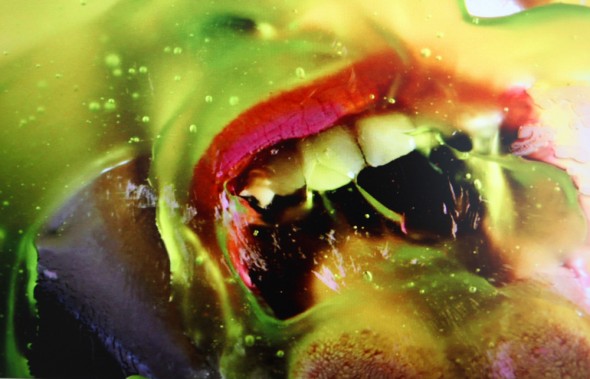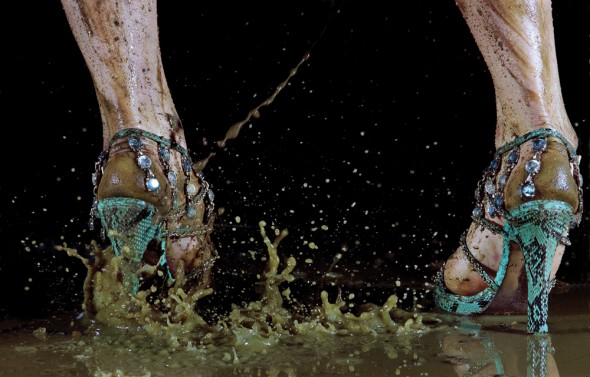
Still from Green Pink Caviar, 2009. HD video, 7:45 minutes.
Marilyn Minter’s Pleasure Principle
It is difficult to tell if Marilyn Minter’s subjects are meant to make viewers uncomfortable—or turn them on. A self-proclaimed “still life art photographer,” Minter’s pornography-inspired portraits of women seemingly possessed by the voyeuristic lens all appear to be objects of her wildest hallucinations. Yet, upon closer inspection, the images reveal the simplest reality that exists in beauty: imperfection. Her camera catches, with peephole discretion, tongues and fingers intermingling with precious stones, body hair and birthday cake, rendering her subjects in a miserable yet erotic state of disarray. Unconventional to be sure, but refreshing nonetheless.
As a social critic, Minter documents deeply rooted cultural insecurities in the pursuit of aesthetic perfection. But she will never admit it. And her modesty almost makes you feel as if you are over analyzing her spontaneous and uncomplicated alterations of regular photographs. “I just make pictures of what already exists,” says Minter of her artistic process. “I don’t define anything.”
Minter’s final products—untouched and uncropped—are amalgamations of several images superimposed and digitally layered onto an initial shot. Multiple coats of high gloss enamel paint add a certain translucency and dimension that is impossible to achieve in a regular photograph or painting. The images are not enhanced; instead, Minter searches for and accentuates the minor imperfections that are usually airbrushed from commercial images. “I like things that are sweaty and wet and drippy,” explains the artist, “I’m not cleaning things up.”
The opposite is also the case, as evidenced by Minter’s contribution to the July 2007 issue of art publication Parkett, which showcased uncharacteristically bare shots of Pamela Anderson. Gone was the overexposed and oversexed image, which was instead stripped of artificial accoutrements in raw images such as “Unarmed” and “Drop.” “It’s easy to stereotype someone who makes their living as a pin-up girl, but Pamela is also a lifetime spokesperson for PETA,” Minter says. “I feel she has incredible empathy. Isn’t she allowed to be vulnerable?”

Shitkicker, 2006. C-print.
Perhaps the artist can relate to her subject’s intense public scrutiny. Her earliest photographs, a series of basic black-and-whites of her mother shot in 1969 for an art class at the University of Florida, depicted a deteriorating, substance abusing parent whose commitment to primping offered a grotesque portrait of a walking contradiction and, assumingly, a clue to Minter’s gross perception of beauty, that she now describes as “askew.” Not surprising given the indifferent responses to the glamour shots by Minter’s first critics: her fellow students. Deftly hidden from view for 25 years, Minter’s infamy burgeoned in the early ’80s and continued to haunt her until 2006 when she was chosen as one of the artists to be included in the Whitney Biennial in New York. “I was demonized,” admits the artist of her reputation in the art world.
Indeed, the sociopolitical zeitgeist after the feminist era of the ’70s was not ready for—and quite unforgiving of—the fetishization and objectification of females engaging in unmentionable acts, their imploring hands and ripe mouths grasping at eager members. Similarly received was Minter’s late-night television commercial, 100 Food Porn, which featured a montage of graphic, pop-art inspired prints of female hands, nails shellacked with glossy red paint; sensually dismembering lobster tails and separating eggs. Like most of her works, the advertisement incorporated mixed media applications to create a multi-dimensional moving art piece whose very composition made a statement about erotic edibles and the hyper-commercialization of consumption.
Because of the social ramifications of creating controversial art, Minter attributes many of her successes to “serendipity” including the creation of her graphic film installation Green Pink Caviar and its appearance on Madonna’s Sticky and Sweet Tour. “I couldn’t have planned for this to happen in a million years,” says the artist of the pairing. Luckily, in an era where choreographed bedroom activities are applauded onstage, Minter’s film of models with long tongues swirling and sucking bakery products from under a pane of glass is acceptable. So acceptable that mainstream corporations are now seeking Minter’s creative edge to sell their products. For their fall line, MAC Cosmetics tapped into the stylized pigments used by three photographers including Minter, to create collections reflective of each artist’s work. In Minter’s palette, a bright, almost incandescent fuchsia takes precedence among eight pots of glitter powder, each one a tube of paint ready to be splashed on the ultimate blank canvas.
With an upcoming exhibit at Los Angeles’ Regen Projects and a highly anticipated new body of work after multiple commercial projects, Marilyn’s late-in-life success can definitely be chalked up to experience. “I’m better at making work,” she says. Better? Maybe. Stimulating? Always.
– Gareen Darakjian

